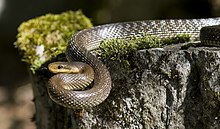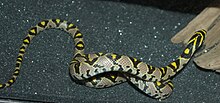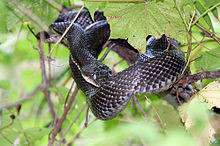Rat snake
This article needs additional citations for verification. (April 2014) |
| Rat snake | |
|---|---|

| |
| Aesculapian snake (Zamenis longissimus) | |
| Scientific classification | |
| Kingdom: | |
| Phylum: | |
| Subphylum: | |
| Class: | |
| Order: | |
| Suborder: | |
| Family: | |
| Subfamily: | |
| Genus: | Various
|
Rat snakes (or ratsnakes) are members – along with kingsnakes, milk snakes, vine snakes and indigo snakes – of the subfamily Colubrinae of the family Colubridae. They are medium to large constrictors and are found throughout much of the Northern Hemisphere. They feed primarily on rodents and birds. With some species exceeding 3 m (10 ft) in total length, they can occupy top levels of some food chains. Many species make attractive and docile pets and one, the corn snake, is one of the most popular reptile pets in the world.[citation needed] Other species can be very skittish and sometimes aggressive, but bites are rarely serious. Like nearly all colubrids, rat snakes pose no threat to humans. Rat snakes were long thought to be completely nonvenomous, but recent studies have shown that some Old World species do possess small amounts of venom, though the amount is negligible relative to humans.[1]
Previously, most rat snakes were assigned to the genus Elaphe, but many have been since renamed following mitochondrial DNA analysis performed in 2002. For the purpose of this article, names will be harmonized with the TIGR Database[clarification needed].
Species
Old World rat snakes




Coelognathus spp
- Philippine rat snake, C. erythrurus (A.M.C. Duméril, Bibron & A.H.A. Duméril, 1854)
- Black copper rat snake or yellow striped snake, C. flavolineatus (Schlegel, 1837)
- Trinket snake, C. helena (Daudin, 1803)
- Copperhead rat snake, C. radiata (F. Boie, 1827)
- Indonesian rat snake, C. subradiata (Schlegel, 1837)
Elaphe spp
- Twin-spotted rat snake, Elaphe bimaculata Schmidt, 1925
- King rat snake, Elaphe carinata (Günther, 1864)
- Japanese rat snake, E. climacophora (H. Boie, 1826)
- David's rat snake, E. davidi (Sauvage, 1884)
- Dione rat snake, E. dione (Pallas, 1773)
- Japanese four-lined rat snake, E. quadrivirgata (H. Boie, 1826)
- Four-lined snake, E. quatuorlineata (Lacépède, 1789)
- Red-backed rat snake, E. rufodorsata (Cantor, 1842)
- Eastern four-lined snake, E. sauromates (Pallas, 1811)
- Russian rat snake, E. schrenckii Strauch, 1873
Euprepiophis spp
- Japanese forest rat snake, E. conspicillatus (H. Boie, 1826)
- Mandarin rat snake, E. mandarinus (Cantor, 1842)
Gonyosoma spp
- Green trinket snake, G. frenatum (Gray, 1853)
- Celebes black-tailed rat snake, G. jansenii (Bleeker, 1858)
- Red-tailed green rat snake, G. oxycephalum (F. Boie, 1827)
Oreocryptophis spp
- Mountain rat snake, O. porphyracea (Cantor, 1839)
Orthriophis spp
- Cantor's rat snake, O. cantoris (Boulenger, 1894)
- Hodgson's rat snake, O. hodgsoni (Günther, 1860)
- 100 flower rat snake, O. moellendorffi (Boettger, 1886)
- Beauty snake, O. taeniurus (Cope, 1861)
Ptyas spp
- Keeled rat snake, P. carinata (Günther, 1858)
- P. dhumnades (Cantor, 1842)
- Sulawesi black racer, P. dipsas (Schlegel, 1837)
- White-bellied rat snake, P. fusca (Günther, 1858)
- Chinese rat snake, P. korros (Schlegel, 1837)
- P. luzonensis (Günther, 1873)
- Oriental rat snake, P. mucosus (Linnaeus, 1758)
- Green rat snake, P. nigromarginatus (Blyth, 1854)
Rhadinophis spp
- Green bush snake, R. prasinus (Blyth, 1854)
Rhynchophis spp
Zamenis spp
- Transcaucasian rat snake, Z. hohenackeri (Strauch, 1873)
- Italian Aesculapian snake, Z. lineatus (Camerano, 1891)
- Aesculapian snake, Z. longissimus (Laurenti, 1768)
- Persian rat snake, Z. persicus (F. Werner, 1913)
- Indian rat snake,

Common India Rat Snake, clicked in Bangalore, Karnataka, India (Aesculapian snake (Zamenis longissimus) - Leopard snake, Z. situla (Linnaeus, 1758)


New World rat snakes
Bogertophis spp
- Baja California ratsnake, B. rosaliae (Mocquard, 1899)
- Trans-Pecos ratsnake, B. subocularis (Brown, 1901)
Pantherophis spp
- Eastern ratsnake, P. alleghaniensis (Holbrook, 1836)
- Baird's ratsnake, P. bairdi (Yarrow, 1880)
- Great Plains ratsnake, P. emoryi (Baird & Girard, 1853)
- Eastern foxsnake, P. gloydi (Conant, 1940)
- Cornsnake, P. guttatus (Linnaeus, 1766)
- Black ratsnake, P. obsoletus (Say, 1823)
- Western foxsnake, Pantherophis ramspotti (Crother, White, Savage, Eckstut, Graham & Gardner, 2011)
- Gray ratsnake, P. spiloides (A.M.C. Duméril, Bibron & A.H.A. Duméril, 1854)
- Eastern foxsnake, P. vulpinus (Baird & Girard, 1853)
Pseudelaphe spp
- Mexican ratsnake, P. flavirufa (Cope, 1867)
Senticolis spp
- Green ratsnake, S. triaspis (Cope, 1866)
Spilotes spp
- Chicken snake or yellow rat snake, S. pullatus (Linnaeus, 1758)
Nota bene: In the above species lists, an authority's name in parentheses indicates that the species was originally described in a different genus. An authority's name not in parentheses indicates that the species is still assigned to the original genus in which it was described.
Taxonomy
In recent years, some taxonomic controversy has occurred over the genus of North American rat snakes. Based on mitochondrial DNA, Utiger et al. (2002) showed that North American rat snakes of the genus Elaphe, along with closely related genera such as Pituophis and Lampropeltis, form a monophyletic group separate from Old World members of the genus. They therefore suggested the resurrection of the available name Pantherophis Fitzinger for all North American taxa (north of Mexico).[2][3] Crother et al. (2008) accepted the taxonomic change to Pantherophis.[4]
In captivity
Rat snakes are commonly kept as pets by reptile enthusiasts. The corn snake, one of the most popular pet reptiles, is a rat snake. New World species are generally thought to be more docile in captivity as opposed to Old World rat snakes, of which the opposite is assumed.[5]
See also
References
- ^ Fry, Bryan G.; Lumsden, Natalie G.; Wüster, Wolfgang; Wickramaratna, Janith C.; Hodgson, Wayne C.; Kini, R. Manjunatha (1 October 2003). "Isolation of a neurotoxin (alpha-colubritoxin) from a nonvenomous colubrid: evidence for early origin of venom in snakes". Journal of Molecular Evolution. 57 (4): 446–452. doi:10.1007/s00239-003-2497-3. ISSN 0022-2844. PMID 14708577.
- ^ "Molecular systematics and phylogeny of Old and New World ratsnakes, Elaphe auct., and related genera (Reptilia, Squamata, Colubridae)" (PDF). Russian Journal of Herpetology. 9 (2): 105–124. 2002.
{{cite journal}}: Unknown parameter|authors=ignored (help) - ^ Elaphe obsoleta at The Center for North American Herpetology. Accessed 20 June 2008.
- ^ Crother BI, et al. (2008) Scientific and Standard English Names of Amphibians and Reptiles of North America North of Mexico: 6th edition. Herp. Rev. 37, pp. 58–59. or see pp. 64 ff in the 7th edition.
- ^ Bartlett, Richard D.; Bartlett, Patricia Pope. Corn Snakes and Other Rat Snakes: Everything about Acquiring, Hosuing, Health, and Breeding. Barron's Educational Series. p. 8. ISBN 9780764134074.
External links

